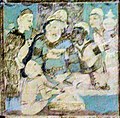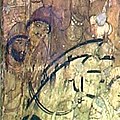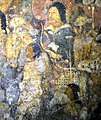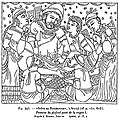Category:Foreigners at Ajanta
Depiction of foreigners at Ajanta frescoes of 5th century CE.
The skin color and dress style of some characters had led to the hypothesis that some of these characters may be foreign and related to the embassy sent from Persia; this theory was proposed in early colonial era literature in the decades after these caves were discovered and studied (see e.g., Fergusson, 1879). However, after the review of Persian records, dating when the embassy was actually sent from Persia by Khusro II Parvez to the Hindu sovereign of early Chalukya dynasty (7th-century), and the better dating of these frescoes and caves to the 5th-century by Walter Spink, this theory has largely been rejected since the Indian painters could not have forecasted who will visit nearly 200 years in future. Further, given the diversity of skin color in South Asia, different skin tones and the diversity of the culture in South Asia, along with limited evidence of these practices in pre-5th-century Greater India, the colonial era proposal that there are many foreigners in Ajanta frescoes has been by questioned and partly rejected by scholars such as Schlingloff (1988), Zin (2003) and others. There are some characters in these frescoes that are dressed in a style found in the artwork of northwest Indian subcontinent, Kushan and Saka-ruled regions. Thus, the basic hypothesis that the painters were showing a diversity of people from far away lands is valid.
Sources: [1] Dieter Schlingloff, Studies in the Ajanta Paintings: Identification and Interpretations, 1988; [2] Monika Zin, Ajanta: Handbuch der Malereien, Devotionale und ornamentale Malereien, Volume 1: Interpretation, 2003.
Media in category "Foreigners at Ajanta"
The following 75 files are in this category, out of 75 total.
-
1880 sketch wall painting Cave 1 Ajanta Maharashtra India.jpg 1,797 × 1,228; 673 KB
-
Ajanta amorous palace scene with foreign servants.jpg 6,267 × 2,623; 3.61 MB
-
Ajanta amorous palace scene.jpg 2,995 × 2,623; 2.16 MB
-
Ajanta Cave 1 ceiling foreign dignitary.jpg 2,616 × 2,319; 4.85 MB
-
Ajanta Cave 1 ceiling medallion couple.jpg 896 × 645; 167 KB
-
Ajanta Cave 1 cherub.jpg 610 × 644; 126 KB
-
Ajanta Cave 1 cupid in foliage.jpg 278 × 1,026; 94 KB
-
Ajanta Cave 1 dressed couple.jpg 756 × 584; 156 KB
-
Ajanta Cave 1 first frescoe to the right of the entrance with three foreigners detail.jpg 4,881 × 1,382; 6.05 MB
-
Ajanta Cave 1 first frescoe to the right of the entrance, three foreigners detail.jpg 1,806 × 1,277; 470 KB
-
Ajanta Cave 1 first frescoe to the right of the entrance, three foreigners.jpg 1,806 × 1,945; 701 KB
-
Ajanta Cave 1 first frescoe to the right of the entrance.jpg 3,032 × 1,382; 1.41 MB
-
Ajanta Cave 1 foreigner with bag.jpg 418 × 452; 57 KB
-
Ajanta Cave 1 foreigners with luggage.jpg 276 × 268; 27 KB
-
Ajanta Cave 1 Group of foreigners.jpg 1,366 × 1,347; 552 KB
-
Ajanta Cave 1 group of revelling foreigners.jpg 1,276 × 1,254; 649 KB
-
Ajanta Cave 1 Group.jpg 1,002 × 648; 727 KB
-
Ajanta Cave 1 Lady in blue dress with tiara.jpg 402 × 699; 129 KB
-
Ajanta Cave 1 Mahajanaka Jataka mural detail with foreigner.jpg 489 × 765; 138 KB
-
Ajanta Cave 1 Mahajanaka Jataka mural with foreigner detail.jpg 898 × 716; 165 KB
-
Ajanta Cave 1 Mahajanaka Jataka painting with foreigner detail and portrait.jpg 1,814 × 1,200; 356 KB
-
Ajanta Cave 1 Mahajanaka Jataka painting with foreigner detail.jpg 2,663 × 1,200; 1 MB
-
Ajanta Cave 1 man with hat.jpg 519 × 896; 143 KB
-
Ajanta Cave 1 Padmapani and attendants.jpg 4,000 × 6,000; 6.09 MB
-
Ajanta Cave 1 pair of foreigners.jpg 597 × 540; 102 KB
-
Ajanta Cave 1 Persian Bacchanale No1.jpg 898 × 778; 310 KB
-
Ajanta Cave 1 Persian Bacchanale No3.jpg 646 × 675; 157 KB
-
Ajanta Cave 1 Persian embassy group.jpg 1,238 × 822; 264 KB
-
Ajanta Cave 1, Ceiling Painting, Ajanta Caves 1-12, Aurangabad.jpg 614 × 588; 140 KB
-
Ajanta Cave 1, Padmapani attendant, Lady in blue dress with tiara.jpg 446 × 730; 612 KB
-
Ajanta Cave 17 black complexion servant with detail.jpg 1,992 × 1,239; 571 KB
-
Ajanta Cave 17 black complexion servant.jpg 1,035 × 1,244; 378 KB
-
Ajanta Cave 17 Descent from Heaven Left Wall foreigners detail.jpg 852 × 1,219; 1,015 KB
-
Ajanta Cave 17 Descent from Heaven Left Wall horsemen detail.jpg 732 × 737; 587 KB
-
Ajanta Cave 17 Foreign devotees to the Buddha.jpg 3,402 × 1,059; 836 KB
-
Ajanta Cave 17 foreign devotees with monkey.jpg 796 × 571; 163 KB
-
Ajanta Cave 17 foreign riders.jpg 621 × 391; 85 KB
-
Ajanta Cave 17 foreign servant.jpg 947 × 1,425; 411 KB
-
Ajanta cave 17 foreigners.jpg 2,850 × 2,487; 4.12 MB
-
Ajanta Cave 17 frescoe detail with dark foreigners.jpg 858 × 1,164; 1.07 MB
-
Ajanta Cave 17 frescoe detail with foreigners on horse.jpg 510 × 421; 70 KB
-
Ajanta Cave 17 frescoe detail with foreigners.jpg 477 × 452; 71 KB
-
Ajanta Cave 17 frescoe detail with two foreigners on horse.jpg 1,036 × 1,032; 801 KB
-
Ajanta cave 17 frescoe detail.jpg 845 × 614; 151 KB
-
Ajanta Cave 17 frescoe.jpg 2,840 × 2,140; 4.19 MB
-
Ajanta Cave 17 horseman holding recurve bow.jpg 545 × 649; 150 KB
-
Ajanta Cave 17 horseman with recurve bow.jpg 384 × 409; 61 KB
-
Ajanta Cave 17 Scene of return from Trayastrimsa Heaven with attendant foreigners.jpg 1,950 × 2,589; 1.01 MB
-
Ajanta Cave 17 two foreigners.jpg 742 × 451; 111 KB
-
Ajanta Cave 2 ceiling foreigners group.jpg 377 × 393; 57 KB
-
Ajanta Cave 2 ceiling foreigners.jpg 359 × 501; 61 KB
-
Ajanta Cave 2 Ceiling huge watermelon.jpg 586 × 739; 94 KB
-
Ajanta Cave 2 foreigners with drink.jpg 361 × 444; 58 KB
-
Ajanta Cave 2 foreigners with watermelon.jpg 490 × 496; 57 KB
-
Ajanta Cave 2 Veranda ceiling foreigners.jpg 1,141 × 896; 352 KB
-
Ajanta Cave 2, ceiling foreigners.jpg 420 × 441; 62 KB
-
Ajanta cave I Chanpeyya Jataka (foreigner detail).jpg 1,056 × 1,536; 1,000 KB
-
Ajanta foreign servants.jpg 3,195 × 2,623; 1.47 MB
-
Ajanta foreigner 1.jpg 2,173 × 1,934; 5.85 MB
-
Ajanta foreigner 2.jpg 1,254 × 1,252; 2.59 MB
-
Ajanta foreigner.jpg 506 × 498; 124 KB
-
Ajanta foreigners on horses, Cave 17.jpg 1,294 × 894; 933 KB
-
AJanta mural with foreigner.jpg 3,508 × 2,631; 8.36 MB
-
Ajanta scene with two foreigners (detail).jpg 684 × 903; 247 KB
-
Ajanta scene with two foreigners.jpg 1,786 × 903; 930 KB
-
Ajanta watermelon and foreigners.jpg 1,527 × 1,947; 1.2 MB
-
Ajanta, ceiling of Cave 1.jpg 1,384 × 1,458; 1.73 MB
-
Foreigner on ceiling of Cave 1at Ajanta Caves photograph.jpg 638 × 598; 162 KB
-
Foreigner on ceiling of Cave 1at Ajanta Caves.jpg 701 × 709; 178 KB
-
Huge watermelon painting in cave no.1.jpg 3,120 × 4,160; 2.84 MB
-
Location of second Persian group on the ceiling of Cave 1 in Ajanta.jpg 2,592 × 1,944; 1.12 MB







































































